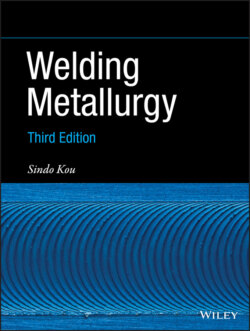Читать книгу Welding Metallurgy - Sindo Kou - Страница 87
Problems
Оглавление1 2.1 In one welding experiment, 50‐mm‐thick steel plates were joined using electroslag welding. The current and voltage were 480 A and 34 V, respectively. The heat losses to the water‐cooled copper shoes and by radiation from the surface of the slag pool were 1275 and 375 cal/s, respectively. Calculate the heat source efficiency.
2 2.2 It has been reported that the heat source efficiency in electroslag welding increases with increasing thickness of the workpiece. Explain why.
3 2.3Consider the welding of 25.4‐mm‐thick steel plates. Do you prefer to apply Rosenthal's two‐ or three‐dimensional heat flow equation for full‐penetration electron beam welds? What about bead‐on‐plate, gas–tungsten arc welds?Suppose you are interested in studying the solidification structure of the weld metal and you wish to calculate the temperature distribution in the weld pool. Do you expect Rosenthal's equations to provide reliable thermal information in the pool? Why or why not?In multipass welding, do you expect a higher or lower cooling rate in the first pass than in the subsequent passes? Why?
4 2.4 Large aluminum sheets 1.6 mm thick are butt welded using GTAW with alternating current. The current, voltage, and welding speed are 100 A, 10 V, and 2 mm/s, respectively. Calculate the peak temperatures at distance of 1.0 and 2.0 mm from the fusion boundary. Assume 50% arc efficiency.
5 2.5 Bead‐on‐plate welding of a thick‐section carbon steel is carried out using 200 A, 20 V, and 2 mm/s. The preheat temperature and arc efficiency are 100 °C and 60%, respectively. Calculate the cross‐sectional area of the weld bead.
6 2.6 (a) Do you expect to have difficulty in achieving steady‐state heat flow during girth (or circumferential) welding of tubes by keeping constant heat input and welding speed? Explain why. What is the consequence of the difficulty? (b) Suggest two methods that help achieve steady‐state heat flow during girth welding.
7 2.7 A cold‐rolled AISI 1010 low‐carbon steel sheet 0.6 mm thick was tested for surface reflectivity in CO2 laser beam welding under the following different surface conditions: (a) as received; (b) oxidized in air furnace at 1000 °C for 20 s; (c) oxidized in air furnace at 1000°C for 40 s; (d) covered with steel powder. In which order does the reflectivity rank in these surface conditions, and why?
8 2.8 It was observed in yttrium‐aluminum‐garnet (YAG) laser beam welding of AISI 409 stainless steel that under the same power the beam size affected the depth–width ratio of the resultant welds significantly. Describe and explain the effect.
9 2.9 Calculate the peak temperature at the top surface of a very thick carbon steel plate at 5 mm away from the fusion line of the weld surface. The power of the arc is 2 kW, the arc efficiency 0.7, the travel speed 2 mm/s, and the preheat temperature 100 °C.
10 2.10 Compare SAW and ESW. (a) Which one has a higher heat efficiency? (b) Explain why.
11 2.11 Compare GMAW and flux‐cored arc welding (FCAW) under the same power input, travel speed, and filler wire deposition rate. Which weld cool down more slowly, and why?
